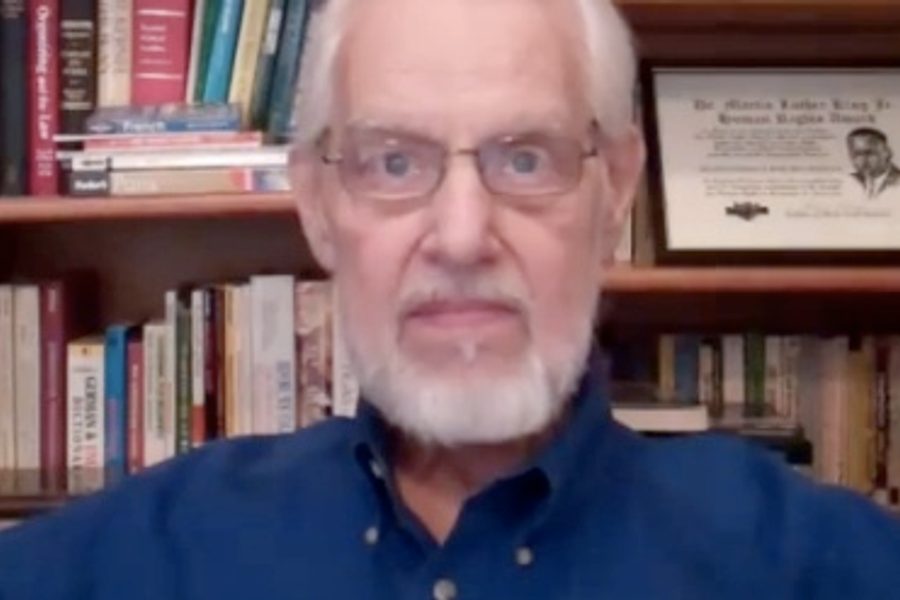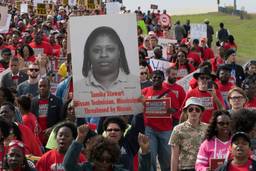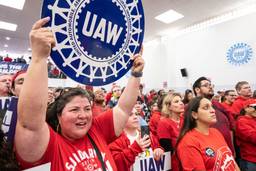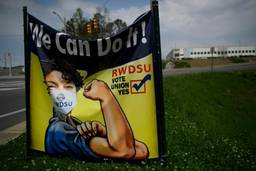
Jerry Tucker, one of the most creative leaders in the labor movement over the past several decades, was not a household name to most Americans – as Walter Reuther, Cesar Chavez or John L. Lewis were – when he died last week of pancreatic cancer. But he was legendary among the workers and progressive labor union staff and officers who worked with him.
Both American workers and their unions would be better off today if Tucker’s influence was greater, and his ideas and strategic models will remain crucial to any future revival of labor. Although his ideas often seemed novel when he proposed them, many were rooted in American history – from the Knights of Labor and the Industrial Workers of the World to the CIO and broader upsurge of the 1930s. They also reflected his outlook that capital – owners and managers – had fundamentally different interests than labor (even if there might be some temporary shared interests). As a leader, he expressed his views forcefully, but philosophically his goal was to empower working people more than to enhance his own power.
“Jerry was very much a commander,” says Bill Fletcher, a long-time union official, author and collaborator with Tucker on some recent projects. “He knew how to assemble a core, to develop strategy, to encourage people to think critically about tactics – and he believed in the members.” He also viewed the job of the labor movement as transforming society, not just serving members. “He talked about labor not simply as looking out for people who belonged to unions, but something broader,” Fletcher recalls, noting that Tucker was “an instinctual as well as a conscious anti-racist.”
Tucker, born in St. Louis in 1938, grew up in a socially conscious union household, but he also played baseball – and was proud to have been the only white player in the local Negro Baseball Sandlot League. In his youth, he headed off to San Francisco for a while during the “Beat” era to write and paint. After graduating from Southern Illinois University, Tucker took a job at General Motors and then Carter Carburetor in the early 1960s. He rose through the ranks of his United Auto Workers (UAW) local, then worked on the international union staff in Washington and as assistant regional director of the eight-state region headquartered in St. Louis.
In 1986 he ran as an insurgent candidate for regional director at the UAW convention. He appeared set to win but at the last minute, the union’s long-dominant administration caucus brought to the convention two union officers from a small Texas local who had not been elected as delegates to cast the deciding votes against him. Tucker challenged the election, and the Labor Department successfully sued to overturn it. He won when the balloting was held again in 1988, but a year later the administration caucus poured enormous effort into a campaign against him, and he lost. He continued for several years to work with the New Directions movement he had launched, conducting a largely symbolic challenge to UAW President Owen Bieber’s re-election, before broadening his attention to the labor movement as a whole.
Tucker continued throughout his life to advise, educate and help workers in contract battles, organizing drives and political campaigns – such as the Labor Campaign for Single Payer Healthcare and U.S. Labor Against the War, both of which he helped to establish. In his organizing work, he tried to figure out ways for workers to gain power by effectively using their own talents and knowledge, by nourishing their solidarity, and by extending their struggles beyond the workplace into their communities.
“An informed and well-organized rank-and-file is at the center of every victorious struggle,” Tucker said in recorded remarks played at a tribute to him held by Labor Notes magazine earlier this year. “The best fight-backs are organized horizontally.”
Tucker applied those ideas in his first big triumph, organizing the 1978 defeat of a Missouri referendum favoring a right-to-work law, which would have barred any arrangement requiring workers in a unionized workplace to pay union dues, even though the union was obliged by law to represent all employees in the bargaining unit. With polls showing the public favoring the referendum 2 to 1 and even a slim majority of union members backing it, labor seemed doomed before Tucker arrived. Instead of hoping that the courts would throw out the initiative petitions, as other union leaders proposed, Tucker assembled a broad coalition that stressed voter registration and grassroots education andcmobilization. Ultimately the referendum went down to defeat, 60 to 40 percent.
Tucker was also primarily responsible for reviving the venerable strategy of “working to rule,” or workers doing only what they were told to do and no more, as well as strictly obeying every rule. Also referred to as the “the inside game,” or in Tucker’s words, “running the plant backwards,” these tactics were an alternative to striking when employers were ready and anxious to bring in strikebreakers.
But the tactics were also a way for workers as a group to use their intimate knowledge of how their work is done to effectively slow down and disrupt production under their control. In many cases, workers felt more powerful using these inside tactics than going out on strike, and at a time of rampant concessions on contracts in the early 1980s, Tucker’s strategy repeatedly led to improved contracts.
His critique of unions offering concessions as a way to avoid layoffs led Tucker into a more general criticism of labor-management partnerships, or “jointness,” as he called it. Beyond questioning its success, Tucker argued that such partnerships – which often were followed by the reverse management strategy of attacks on workers – made the union and its members unprepared to fight back when they needed to do so. He often said that workers need a union to contest management decisions, but nobody needs a union just to cooperate with management.
Michael Cannon, Tucker’s friend and staff assistant at the UAW for many years, recalls, “Jerry used to always say to me, ‘Michael, it always comes down to labor versus capital.’”
Union leaders and groups of workers called on Tucker in his years after the UAW for advice and assistance, particularly when times were tough, as in the Decatur, Ill., “war zone” strikes and lockouts at Staley, Caterpillar and Firestone in the early ’90s. Among his contributions, Tucker worked with the local union’s “road warrior” members to organize public pressure on businesses using Staley’s corn products to switch suppliers, carefully circumventing a call for a consumer boycott of the products that might have been declared an illegal secondary boycott. The campaign started with Miller beers, and eight months later, Miller dropped Staley as a supplier.
Despite his contributions, top officers in the labor movement often tried to exclude Tucker, such as Paperworkers officials arguing that he should not be involved with the Decatur Staley local, or UAW officials insuring that his name be kept out of an AFL-CIO publication featuring much of his work on “the inside game,” according to Peter Olney, organizing director at the International Longshore and Warehouse Union.
Over the past decade, Tucker was involved with a group of progressive unionists in forming, first, a group called Labor Left, then the Center for Labor Renewal, which has held “solidarity schools,” where Tucker was an important teacher, according to New Directions colleague Elly Leary.
Most people who knew him had a personal Jerry story that captured some of the qualities that inspired friends – or infuriated foes. I had known and written about Tucker since the right-to-work fight, but I particularly recall a spring day in 1985 in Plattsburg, Missouri, where Tucker had brought a delegation of auto workers to support Perry Wilson, a 73-year-old farmer who faced foreclosure on his farm mortgage and the sale of his land and possessions. At the courthouse, nearly 50 law enforcement officers had gathered to permit the trustee for the Federal Land Bank, a publicly chartered but private lender, to conduct the sale.
But as the door opened at 2 pm, a crowd of hundreds of farmers and autoworkers surged forward, pushing back the phalanx of police, shouting, “No sale, no sale,” so loudly that it drowned out the trustee and ultimately stopped the sale. As I tried to get close to cover the event, I ended up getting trapped in the crowd near the front line. As the police pushed against me, I found myself being pushed back toward them by the formidably strong Jerry Tucker, who was not letting up until the sale was canceled. Though I worried about compromising professional journalistic ethics, my heart was with the protesters, and Jerry luckily had no hesitation about helping to literally put his body – and mine – on the line.
Tucker had an appreciation of the value of many ways to advance workers’ interests, including electoral politics, but he always seemed particularly at home with such direct action by workers allied with the broader community against the interests of capital.
His impulse to help never faded. A little more than a week before he died, he was talking from the hospital with his friend, Michael Cannon. “I need some work,” he said. “I’m just sitting here.”
“You’ve helped a lot of people,” Cannon said. “Now it’s time to help yourself and your family.”
“I guess so,” Tucker replied, reluctant to let go of the grand causes that animated him, a man who gave much to working people in America, and who, should the lessons from his life be heeded, could still give so much more.

I hope you found this article important. Before you leave, I want to ask you to consider supporting our work with a donation. In These Times needs readers like you to help sustain our mission. We don’t depend on—or want—corporate advertising or deep-pocketed billionaires to fund our journalism. We’re supported by you, the reader, so we can focus on covering the issues that matter most to the progressive movement without fear or compromise.
Our work isn’t hidden behind a paywall because of people like you who support our journalism. We want to keep it that way. If you value the work we do and the movements we cover, please consider donating to In These Times.
David Moberg, a former senior editor of In These Times, was on staff with the magazine from when it began publishing in 1976 until his passing in July 2022. Before joining In These Times, he completed his work for a Ph.D. in anthropology at the University of Chicago and worked for Newsweek. He received fellowships from the John D. and Catherine T. MacArthur Foundation and the Nation Institute for research on the new global economy.







